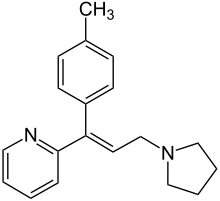Triprolidine is an over-the-counter antihistamine with anticholinergic properties.[1] It is used to combat the symptoms associated with allergies and is sometimes combined with other cold medications designed to provide general relief for flu-like symptoms.[2] As with many antihistamines, the most common side effect is drowsiness.[1]
 | |
| Clinical data | |
|---|---|
| Trade names | Flonase Nighttime Allergy Relief, Actidil, Myidil, Actifed (in the latter combined with pseudoephedrine and either dextromethorphan or guaifenesin) |
| AHFS/Drugs.com | Monograph |
| Pregnancy category |
|
| Routes of administration | Oral |
| ATC code | |
| Legal status | |
| Legal status |
|
| Pharmacokinetic data | |
| Bioavailability | 4% oral |
| Protein binding | 90% |
| Metabolism | Hepatic (CYP2D6) |
| Elimination half-life | 4–6 hours |
| Excretion | Renal |
| Identifiers | |
| |
| CAS Number | |
| PubChem CID | |
| IUPHAR/BPS | |
| DrugBank | |
| ChemSpider | |
| UNII | |
| KEGG | |
| ChEBI | |
| ChEMBL | |
| CompTox Dashboard (EPA) | |
| ECHA InfoCard | 100.006.934 |
| Chemical and physical data | |
| Formula | C19H22N2 |
| Molar mass | 278.399 g·mol−1 |
| 3D model (JSmol) | |
| Melting point | 60 °C (140 °F) |
| Solubility in water | 500 mg/mL (20 °C) |
| |
| |
| | |
Today, Triprolidine is not very much used anymore, and was mostly replaced by other, more popular antihistamines like Diphenhydramine, Promethazine, Chlorpheniramine, as well as second generation antihistamines like Loratadine and Fexofenadine.
It was patented in 1948 and came into medical use in 1953.[3]
See also
editReferences
edit- ^ a b Goldsmith P, Dowd PM (January 1993). "The new H1 antihistamines. Treatment of urticaria and other clinical problems". Dermatologic Clinics. 11 (1): 87–95. doi:10.1016/S0733-8635(18)30285-7. PMID 8094649.
- ^ Williams BO, Liao SH, Lai AA, Arnold JD, Perkins JG, Blum MR, Findlay JW (1984). "Bioavailability of pseudoephedrine and triprolidine from combination and single-ingredient products". Clinical Pharmacy. 3 (6): 638–43. PMID 6509877.
- ^ Fischer J, Ganellin CR (2006). Analogue-based Drug Discovery. John Wiley & Sons. p. 546. ISBN 9783527607495.